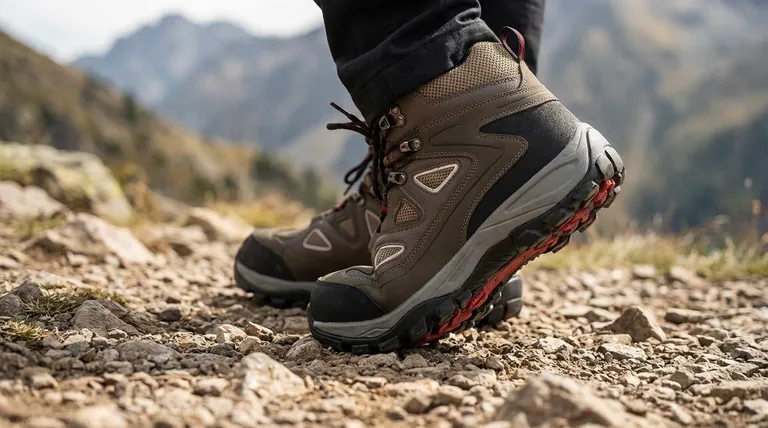The single most critical element of a proper boot fit is ensuring the boot’s flex point perfectly aligns with your foot's natural bending point. This alignment, which occurs at the ball of your foot (your toe line), dictates whether the boot works with your body or against it. When misaligned, even the most expensive boot will cause discomfort and instability.
A boot's flex point is not a feature; it is the foundation of a functional fit. If the boot bends where your foot doesn't, you will experience friction, instability, and foot fatigue, regardless of the boot's other qualities.

The Mechanics of a Proper Flex
A well-fitting boot should feel like an extension of your own foot. The flex point is the primary driver of this synergy.
What is the Flex Point?
The flex point is the location where the boot's upper material naturally creases as you roll forward onto the ball of your foot during a step. It is the boot's engineered "hinge."
Why Alignment is Non-Negotiable
Your foot has its own natural hinge: the metatarsophalangeal joints, more commonly known as the ball of your foot. For a proper fit, the boot's flex point must align precisely with this anatomical point.
This ensures that as you walk, the boot bends in perfect concert with your foot, eliminating internal resistance and movement.
The True Measure: Arch Length
The correct flex point is determined by your arch length (the distance from your heel to the ball of your foot), not just your overall foot length.
This is why two people with the same size foot might require different boots. The boot's widest part must match the widest part of your foot—the ball—which is also the correct flex point.
Consequences of a Mismatched Flex Point
When the flex point is wrong, you are forcing your foot to fight the boot's structure with every step. This creates a cascade of negative effects.
Constant Friction and Blisters
If the boot bends too far forward or too far back, it will rub against the top of your foot or your toes. This constant friction is a primary cause of painful hot spots and blisters.
Instability and Heel Slip
A misaligned flex point prevents your foot from staying securely in the heel pocket. As you walk, your foot will slide back and forth inside the boot, leading to heel slip, a lack of stability, and potential toe-banging on descents.
Arch Strain and Fatigue
When the boot's flex point doesn't support your foot's natural movement, your arch can become strained. Your foot muscles must work harder to compensate, leading to premature fatigue and discomfort.
How to Test for the Correct Flex Point
You can verify the flex point in a few seconds, both before and after you put the boot on.
The In-Hand Test
Hold the boot with one hand on the heel and the other on the toe. Push the toe upwards towards the laces. The boot should bend easily at a point that corresponds to the ball of the foot, not in the middle of the arch.
The On-Foot Test
Put the boot on and lace it up. Stand up and rock forward onto your toes. Pay close attention to where the boot creases. You should feel the bend happen exactly where your toes meet your foot, with no pinching or pressure.
Making the Right Choice for Your Fit
Your goal is to find a boot that matches your unique foot geometry. Focusing on the flex point is the most direct way to achieve this.
- If your primary focus is avoiding pain: Prioritize the on-foot test to ensure the boot's crease aligns perfectly with your foot's natural bend.
- If your primary focus is stability on uneven terrain: A correct flex point will lock your heel in place, which is the most important factor for ankle support and control.
- If your primary focus is long-distance comfort: A boot that flexes with your foot, not against it, will dramatically reduce fatigue over many miles.
Understanding and prioritizing the flex point turns boot fitting from a guess into a precise process, ensuring comfort and performance.
Summary Table:
| Flex Point Status | Impact on Wearer | Primary Symptoms |
|---|---|---|
| Correctly Aligned | Boot works with your foot's natural movement. | Enhanced stability, comfort, and reduced fatigue. |
| Misaligned | Boot fights against your foot's mechanics. | Blisters, heel slip, instability, and arch strain. |
Need boots that fit perfectly from the first step?
As a large-scale manufacturer, 3515 produces a comprehensive range of footwear for distributors, brand owners, and bulk clients. Our production capabilities encompass all types of shoes and boots, engineered with precise flex points for superior comfort and performance.
Contact our experts today to discuss your footwear needs and discover how we can deliver the perfect fit for your customers.
Visual Guide

Related Products
- Safety Footwear Wholesale Manufacturer for Custom OEM/ODM Production
- Wholesale Breathable & Cushioned Training Shoes Custom Factory Production
- Wholesale Training Shoes with Dial Lacing System Custom OEM Manufacturing
- Heavy-Duty Goodyear Welted Pull-On Safety Rigger Boot
- Premium Wholesale Tactical Style Safety Shoes Boots with Quick Lacing
People Also Ask
- Is safety-toe as good as steel toe? Choose the Right Protection for Your Job
- Do snake bite boots work? Your Ultimate Guide to Effective Snake Bite Protection
- What are the cultural perspectives on wearing shoes in the house? A Guide to Home Etiquette & Hygiene
- How do safety shoes contribute to cost savings for companies? A Strategic Investment in Risk and Cost Management
- How long can you wear safety boots? The Lifespan is Determined by Wear, Not Time



















